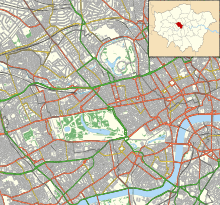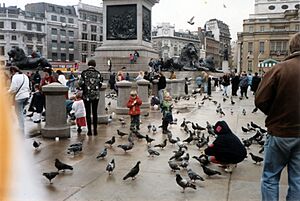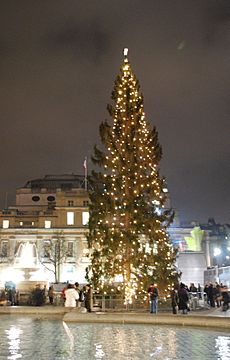Trafalgar Square facts for kids
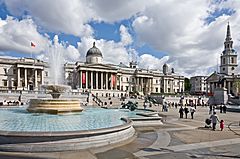
View of the square in 2009
|
|
| Former name(s) | Charing Cross |
|---|---|
| Namesake | Battle of Trafalgar |
| Maintained by | Greater London Authority |
| Location | City of Westminster, London, England |
| Postal code | WC2 |
| Coordinates | 51°30′29″N 00°07′41″W / 51.50806°N 0.12806°W |
| North | Charing Cross Road |
| East | The Strand |
| South | Northumberland Avenue Whitehall |
| West | The Mall |
| Construction | |
| Completion | c. 1840 |
| Other | |
| Designer | Sir Charles Barry |
Trafalgar Square is a famous public square in Central London, England. It was created in the early 1800s in an area once known as Charing Cross. The square is named after the Battle of Trafalgar. This was a big victory for the British Navy during the Napoleonic Wars. The battle happened on October 21, 1805, off the coast of Cape Trafalgar.
The area around Trafalgar Square has been important since the 1200s. For many centuries, distances in London were measured from Charing Cross. Before the square was built, this spot held the Royal Mews, which were stables for the King's horses. After King George IV moved the stables, the area was redesigned by John Nash. However, it took a long time to finish, and the square officially opened in 1844.
At the center of the square stands the tall Nelson's Column, which is about 51 meters (169 feet) high. Four large lion statues guard its base. Many other statues and sculptures are also in the square. The Fourth Plinth, which was empty for a long time, has shown modern art since 1999. Important buildings around the square include the National Gallery, St Martin-in-the-Fields church, Canada House, and South Africa House.
Trafalgar Square is a popular place for people to gather. It has been used for community events and even political protests. Every year since 1947, Norway donates a Christmas tree to the square. This gift shows thanks for Britain's help during World War II. The square is also a main spot for New Year's Eve celebrations. It used to be famous for its many feral pigeons, but most of them were removed in the early 2000s.
Contents
What's in a Name?
The square gets its name from the Battle of Trafalgar. This was a major British naval victory against France and Spain. The battle happened on October 21, 1805, near Cape Trafalgar in southwest Spain. The square wasn't officially named Trafalgar Square until 1835.
The word "Trafalgar" comes from Spanish. It is believed to come from Arabic words meaning "cape of the cave" or "extremity of the west."
Exploring the Square
Trafalgar Square is owned by the King and managed by the Greater London Authority. The roads around it are owned by Westminster City Council. The square has a large central area with roads on three sides. A pedestrian area is on the north side, in front of the National Gallery. The roads around the square are part of the A4, a main road in London. In 2003, the northern road was closed to traffic, making more space for people.
Nelson's Column and Fountains
Nelson's Column stands proudly in the middle of the square. It has a statue of Horatio Nelson at the top. Nelson led the British Navy to victory at the Battle of Trafalgar. Around the column are fountains designed by Sir Edwin Lutyens. Four huge bronze lions, sculpted by Sir Edwin Landseer, guard the column's base. These lions were added much later, in 1867.
Buildings Around the Square
The National Gallery is on the north side of the square. To the east is St Martin-in-the-Fields Church and South Africa House. Across the square from South Africa House is Canada House. To the southwest, The Mall leads towards Buckingham Palace. Whitehall is to the south, and the Strand is to the east. Charing Cross Road runs between the National Gallery and the church.
Getting There
You can easily reach Trafalgar Square by public transport. London Underground's Charing Cross station has an exit right in the square. This station serves the Northern and Bakerloo lines. Other nearby tube stations include Embankment and Leicester Square. Many London bus routes also pass through Trafalgar Square.
Trafalgar Square is considered the official center of London. Distances from the capital are often measured from this point.
History of the Square
Long ago, the area where Trafalgar Square now stands was home to ancient animals. Building work in the 1950s uncovered remains of cave lions, rhinoceroses, elephants, and hippopotami.
The site has been important since the 1200s. During the time of King Edward I, it held the King's Mews. This was where the King's hawks were kept for moulting. Later, after a fire in 1534, the mews were rebuilt as stables for horses. They stayed there until King George IV moved them to Buckingham Palace.
Creating the Square
In 1826, John Nash was asked to design a new public space. His plans included clearing a large area and creating what would become Trafalgar Square. Nash passed away before the project was finished, which slowed things down. Around 1835, it was decided to name the square after the Battle of Trafalgar.
The National Gallery was built on the north side between 1832 and 1838. In 1840, new plans by Charles Barry were accepted, and construction began. Barry designed the square with a raised terrace and steps on the north side to make the National Gallery look more impressive. The square was officially opened to the public on May 1, 1844.
Nelson's Column's Story
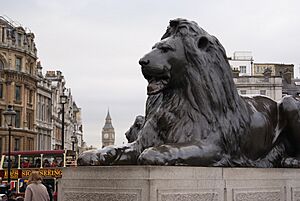
Nelson's Column was planned separately from the rest of the square. In 1838, a group wanted to build a monument to Nelson's victory. An architect named William Railton won a competition with his design for a tall column topped by a statue of Nelson and guarded by four lions. Construction started in 1840, and the column was completed in 1843.
However, the bronze reliefs on the column's base weren't finished until 1854. The famous lion statues were only added in 1867, almost 30 years after the square opened! Each lion weighs seven tons. The sculptor, Edwin Landseer, took a long time to finish the lions. He even used a dead lion from the London Zoo as a model, but it started to decompose, so he had to improvise some parts. This is why some people say the lions' paws look more like a cat's than a lion's.
Incidents and Changes
In the early 1900s, the square was involved in some incidents. In 1913 and 1914, there were small explosions near the National Gallery and inside St Martin-in-the-Fields church. These caused damage to windows and started a fire in the church.
A big renovation of the square finished in 2003. The road on the north side was closed to traffic, and wide steps were added. This made it easier for people to walk from the square to the National Gallery. New lifts were also added for disabled access, along with public toilets and a café.
Statues and Monuments
Trafalgar Square is home to many statues and monuments that honor important people.
The Plinths

On the north side of the square, there are two plinths (stone bases) for sculptures. A bronze statue of King George IV on horseback was placed on the eastern plinth in 1843. The other plinths remained empty for a long time. Two other statues were added in the 1800s: General Sir Charles James Napier in the southwest corner (1855) and Major-General Sir Henry Havelock in the southeast (1861).
The Fourth Plinth
The empty plinth in the northwest corner is known as the "Fourth Plinth." Since the 2000s, it has been used to display special temporary artworks. Artists are chosen to create new sculptures for this spot, which change every so often.
Other Sculptures
Along the north wall of the square, you can see busts (head and shoulders statues) of three admirals: John Jellicoe, 1st Earl Jellicoe, David Beatty, 1st Earl Beatty, and Andrew Cunningham, 1st Viscount Cunningham of Hyndhope.
On the south side of the square, where Charing Cross originally stood, there is a bronze statue of King Charles I on horseback. It was made in 1633 and placed here in 1678.
In front of the National Gallery, there are two more statues. One is of King James II, and the other is a replica of a statue of George Washington. This statue of Washington was a gift from the state of Virginia in the United States, installed in 1921.
Some statues have been moved over time. A statue of Edward Jenner, who created the smallpox vaccine, was once in the square but moved to Kensington Gardens in 1862. Another statue of General Charles George Gordon was also removed in 1943 and moved to the Victoria Embankment.
Fountains
In 1841, it was decided to add two fountains to the square. They were meant to help cool the area and reduce glare from the asphalt surface. The fountains also helped reduce the space available for large crowds, which authorities thought would prevent riots.
In the late 1930s, the fountains were updated with new designs by Sir Edwin Lutyens. These new fountains also served as memorials to Lord Jellicoe and Lord Beatty. The original fountain parts were given to the Canadian government and are now in parks in Ottawa and Regina.
In 2009, the fountains were restored. A new pump system was installed that can shoot water 24 meters (80 feet) into the air. An LED lighting system was also added. This system can project different colors onto the fountains, making them look beautiful at night.
The Pigeons of Trafalgar Square
Trafalgar Square was once famous for its many feral pigeons. Feeding them was a very popular activity for visitors. Pigeons started gathering in the square even before it was fully built. However, the pigeons caused problems. Their droppings damaged the stone buildings and statues, and the large number of birds (sometimes up to 35,000) was seen as a health risk.
In 2001, selling bird seed in the square was stopped. Other methods were used to discourage the pigeons, like using birds of prey. In 2003, the Mayor of London, Ken Livingstone, made rules to ban feeding the birds in the square. Later, Westminster City Council also banned feeding birds on the pedestrian areas. Nelson's Column needed expensive repairs because of damage from pigeon droppings.
Events and Celebrations
New Year's Eve
For many years, people have gathered in Trafalgar Square to celebrate New Year. Even without official events, crowds would come. Since 2003, a large firework display has been held near the London Eye and the River Thames as an alternative. Since 2014, the New Year celebrations in the square have been organized with tickets to control the number of people.
Christmas Tree
A special Christmas ceremony has taken place in the square every year since 1947. Norway's capital city, Oslo, gives London a large Norway spruce (Christmas tree). This is a thank you gift for Britain's help during World War II.
The Christmas tree is decorated with lights that are switched on in a special ceremony. This usually happens twelve days before Christmas Day. The event is open to everyone and attracts many people. After the lights are switched on, there are often nights of Christmas carol singing and other performances. On the twelfth night of Christmas, the tree is taken down and recycled.
Sporting Events
In recent years, Trafalgar Square has hosted several sporting events and victory parades. In 2002, 12,000 people watched England's FIFA World Cup match on giant screens. The square was also used to celebrate England's victory in the Rugby World Cup in 2003 and England's win in the Ashes cricket series in 2005.
In 2005, Trafalgar Square was the official watch party location for London's bid to host the 2012 Summer Olympics. In 2007, it hosted the opening ceremonies of the Tour de France cycling race.
Other Uses
The Sea Cadets hold a yearly parade to celebrate the Battle of Trafalgar victory. This parade runs from Horse Guard's Parade to Nelson's Column.
Trafalgar Square has appeared in many films and TV shows, especially during the 1960s. In May 2007, the square was temporarily covered with grass for two days. This was part of a campaign to promote "green spaces" in London.
In July 2011, the world premiere of the final Harry Potter film, Harry Potter and the Deathly Hallows – Part 2, was held in Trafalgar Square. Fans camped out for days to see the event. It was the first film premiere ever held in the square.
The square has also seen discussions about busking and street theatre. In 2012, rules were made to manage these performances.
Other Trafalgar Squares
Did you know there are other places named Trafalgar Square? A Trafalgar Square was recorded in Stepney, London, in 1810. There's also a Trafalgar Square in Scarborough, North Yorkshire, which gives its name to a part of the town's cricket ground.
A square in Chelsea Square, London, was once known as Trafalgar Square and was named before the famous one in Westminster.
National Heroes Square in Bridgetown, Barbados, was called Trafalgar Square in 1813, even before the London one. It was renamed in 1999 to honor Barbados' national heroes. There is also a life-size copy of the square in Bahria Town, Lahore, Pakistan, which is a tourist attraction.
See also
 In Spanish: Trafalgar Square para niños
In Spanish: Trafalgar Square para niños


